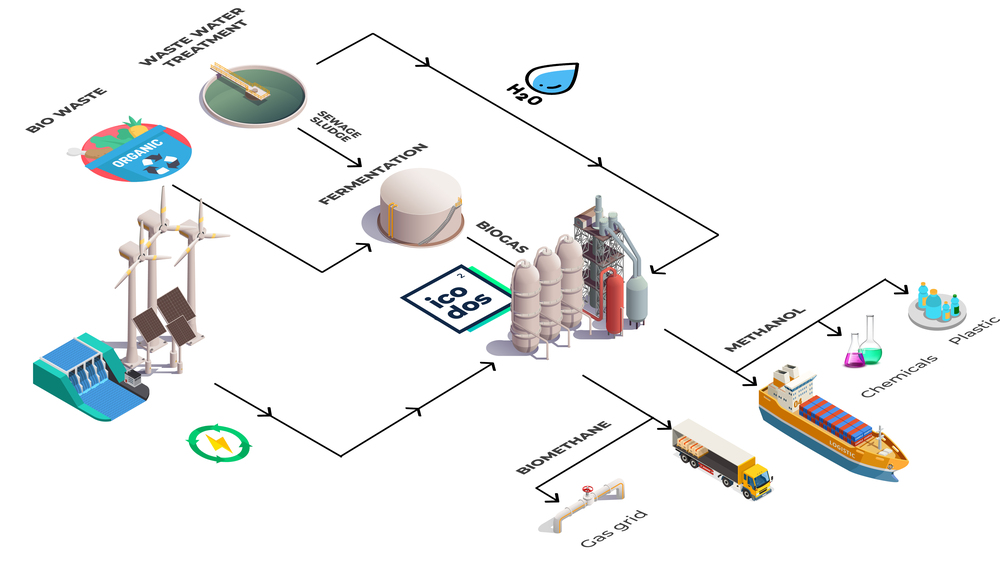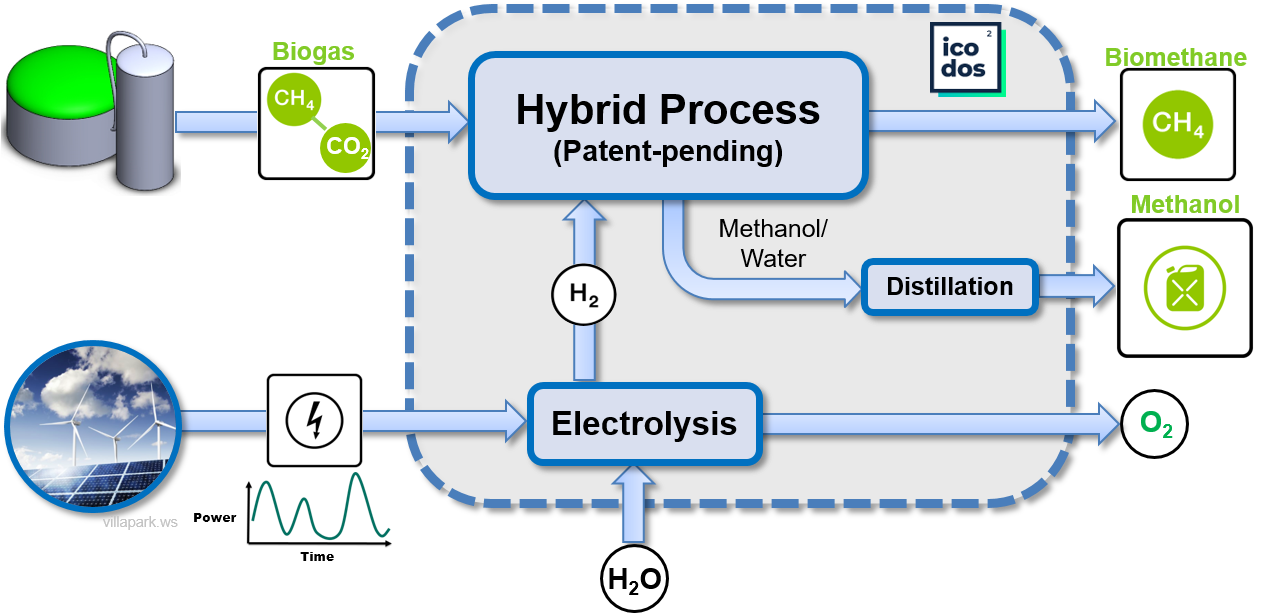ICODOS
Background
The climate crisis is accelerating. Global warming, greenhouse gas emissions and deforestation are causing weather extremes, food shortages and health problems. Emissions come mainly from burning fossil fuels such as oil, coal, natural gas. Commercially competitive solutions are needed to manage the transition to renewable fuels. Currently, e-fuels and bio-fuels are many times more expensive than fossil fuels and therefore not affordable and attractive. This is a challenge that we want to address.
We offer a solution for the utilization of biogas from waste streams such as sewage sludge and biological waste in combination with renewable electricity to produce biomethane and e-methanol. In our process, carbon dioxide (CO2) is captured from the biogas and converted to methanol with additional green hydrogen (H2) from water electrolysis in a combined process. Biogas is a carbon neutral source of energy and CO2, but faces the challenge of expensive gas upgrading for use as fuel. On the other hand, a CO2 source is needed to produce e-fuels, which drives up costs. With our technology, we can upgrade biogas to high-quality biomethane and simultaneously produce green e-methanol from the resulting CO2. This creates a win-win situation. The unique combination of CO2 capture and methanol synthesis, for which KIT has filed a patent application, makes it the most efficient CO2 capture technology and the ultimate tool for realizing a circular bioeconomy in which CO2 previously captured from the air by plants is converted into e-fuels. Although we will initially focus on biogas in implementing our technology, we plan to make it available for other CO2 point sources, such as the cement industry. The following figure shows the value chain with ICODOS' integrated technology.

Value chain with the technology of ICODOS.
Brief description of the technology
Our innovation is the most efficient CO2 capture technology by today's standards. We plan to use it in highly automated and mass-produced plants. In the known processes for the production of e-methanol, CO2 capture and methanol synthesis are separated. In our patent-pending process, these two processes are combined to form the so-called hybrid process. The following figure shows the combined process integrated with the other plant components.
The novel process lowers the investment and operating costs by reducing the energy demand for compression as well as the overall equipment required. The product of methanol synthesis is used as a solvent for CO2 and our process regenerates it continuously. Therefore, there is no reduction in performance over time due to solvent degradation or loss, as is the case with competing amine-based CO2 capture. The life of the system is increased and maintenance is reduced because the problems common to amine scrubbing, such as corrosion or solvent degradation, do not occur. In addition, the integration of the two processes reduces the number of instruments and interfaces. These advantages also facilitate the implementation of full automation of the process.

Illustration of the hybrid process: In the example shown here, the CO2 contained in the biogas is captured, upgraded to biomethane, and then used for methanol synthesis.
Status of the technology and the planned spin-off
For the validation of the integrated technology (hybrid process, distillation and electrolysis) already more than 1 M€ of funding could be generated for a pilot plant with a capacity of approx. 50 L/day methanol. The plant is currently under construction and will be integrated into the KIT Energy Lab 2.0. The current plan is to start up the plant at the end of 2022 in order to validate the technology in a realistic environment in 2023.
The founding team of ICODOS is currently seeking seed funding for the project in order to start operations in addition to validating and further scaling the technology and preparing for manufacturing of the equipment.
In order to support the targeted start-up financing, the ICODOS team is looking forward to connecting and exchanging ideas with stakeholders from the entire value chain.
